#justinian
Explore tagged Tumblr posts
Text


Hagia Sophia Grand Mosque by paandeli.
#hagia sophia#ayasofya#mosque#church#istanbul#turkey#türkiye#roman empire#ottoman#ottoman empire#greek orthodox#latin catholic#justinian#byzantine#alternative#aesthetic#dark academia#dark academic aesthetic#dark aesthetic#aestheitcs#dark#art#light acadamia aesthetic#light academia
536 notes
·
View notes
Text
Emperor Door ∼ Hagia Sophia

#Hagia Sophia#Emperor Door#Religious Art#Deesis#Mosaic#Art#Bronze#Oak#Door#Ottoman#Mosque#Byzantium#Church#Justinian#Architecture#Constantinople#Ayasofya#Museum#Istanbul#Turkey
105 notes
·
View notes
Text

Justinian and Theodora romance sketch! I totally love these two as a couple-- the courtesan that married a prince!-- and there's not much art for them out there. So here it is, @byzantine-suggestions and @margaretkart!
#justinian#justinian and theodora#theodora#empress theodora#art#illustration#sketchbook#sketch#romance art#byzantine empire#byzantium#ancient rome
110 notes
·
View notes
Text
TIL from a podcast featuring historian and Byzantine archaeologist Yannis Theoharis:
Athens was one of the most religiously conservative cities of the Byzantine Empire. It adhered to the ancient Greek religion for longer than most other areas. Contrary to popular belief, its eventual conversion to Christianity did not happen violently. Christianity was getting more and more ground amongst the believers progressively. Meanwhile, the ancient temples and shrines were progressively emptying but as long as there were believers they were functioning properly and had guards and went through restoration works and all, as stated by Neoplatonic philosopher Proklos (with the exception of nude sculptures which had been destroyed already by proto-Christians). The historian also claims the conversion of the temples to churches happened later than what was previously believed, around the 7th-9th centuries. As the vast majority of the population had eventually converted to Christianity, the temples were left abandoned. The empire ordered their conversion to churches so that funding their preservation could be justified. Furthermore, there wasn’t as much of violent banning of ancient schools as it was thought. Justinian did not ban the function of the Neoplatonic school in Athens but ceased the state funding unless the school accepted to add Christian theology to its curriculum. The Neoplatonic school refused but it was not banned. It kept functioning using its own private funds until this wasn’t enough and the school had to close. Evidence for this is that it is documented that the school functioned for several decades or more than a century (don’t remember exactly) after Justinian’s imperial command, which was previously viewed as an immediate or violent shutdown. Meanwhile, the Neoplatonic school in Alexandria (in Egypt) agreed to add Christian theology to its curriculum and it kept functioning undisturbed until the 7th century and the Arab conquest.
Also, he has more insight into the similarities observed between Eastern / Greek and even all Orthodoxy and the Ancient Greek religion, such as idol / icon worship, lesser deity / saint worship, virgin female deity / super saint worship, patron gods / saints etc He says there was an interesting cycle of Christianised Hellenism followed by Hellenized Christianity. Some of these elements of Christian Orthodoxy were emphasized more than in the early years of Proto-Christianity or even exaggerated by the Byzantine Greek Christians in order to attract the pagan Greeks and make them understand more easily the philosophy of the new religion and find common ground between them. It worked.
Lastly, he disputed the dated assumptions that the Visigoth king Alaric I was assisted by monks to destroy Athens during his invasion in 396. This was falsely concluded because in documents it was found that Alaric was accompanied by men clad in black. Theoharis says these were actually Thracian soldiers (Alaric indeed fared long in Thrace and the Thracians were by large mercenaries) and supports it is very unlikely based on historical evidence of the time that Athenian or Greek Christians would collaborate with a Visigoth invader to help him destroy historical areas of Athens, even if they were pagan.
These are the most important bits from memory, I am linking the podcast here, it is in Greek.
#Greece#Europe#history#Greek history#Byzantine history#Christian orthodoxy#Ancient Greek religion#Greek orthodoxy#Eastern Orthodoxy#Byzantine empire#eastern Roman Empire#justinian#Alaric I#proklos#neoplatonism#Athens#attica#central Greece#Sterea Hellas#mainland
106 notes
·
View notes
Text

Don’t know anyone like them out there but I’m postin anyways
Belisarius and Mundus protecting Justinian in Nika Roit!
20 notes
·
View notes
Text
youtube
This is why we learn in textbooks about Rome "falling" in 476: it is literally Roman propaganda about Rome itself.
17 notes
·
View notes
Note
What do you think of Justinian's reign as emperor? A new biography of him that gives fairly positive conclusions on his reign just came out at around the same time as Anthony Kaldelis new history of the byzantines which has a basically equally negative reading of the same subject.
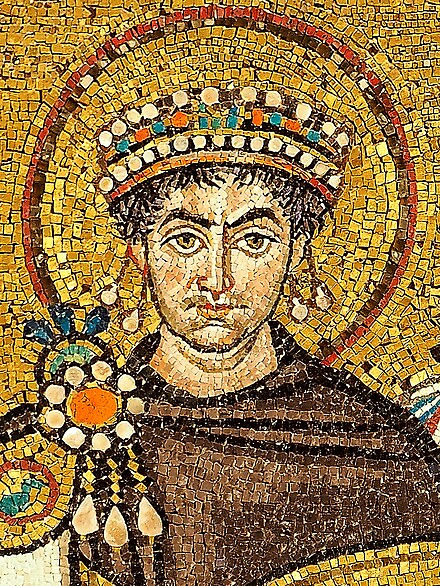
An odd mix of extreme competence in many areas of governance, but so much of that energy was directed at an impossible and arguably counter-productive goal.
He should have stuck with North Africa and the Mediterranean islands so as to preserve his resources for the more important conflict with Khosrau of Persia, rather than waste blood and treasure trying to conquer an empty Rome.
38 notes
·
View notes
Text
Empress Theodora entering Hagia Soph..
oh wait, it's Alicent.

#byzantine#byzantium#game of thrones#house of the dragon#hotd#alicent hightower#rhaenyra targaryen#daemon targaryen#hagia sophia#constantinople#roman empire#late roman empire#late antiquity#house targaryen#team green#team black#hbo#hbo max#theodora#justinian#empress
28 notes
·
View notes
Text
The HILLSBOROUGH DISASTER has NOTHING on the NIKA RIOTS
ON THIS DAY, 532 AD



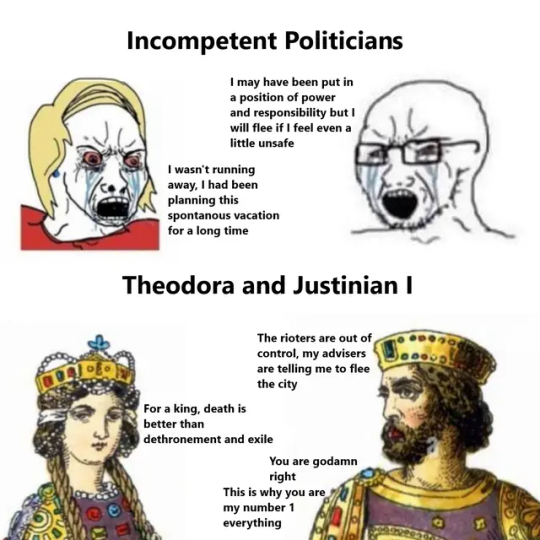
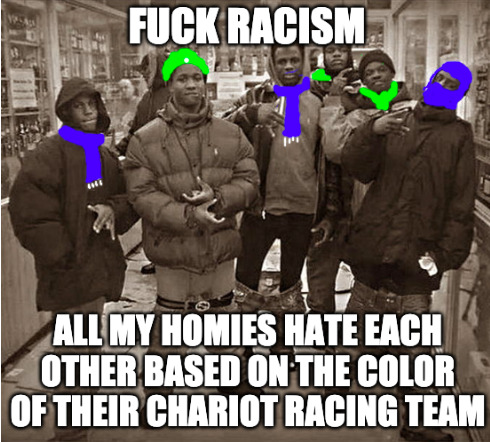
#history#ancient history#classics#ancient greek#ancient greece#ancient rome#roman#greece#constantinople#justinian#theodora#sport#sports#on this day#on this date#medieval#middle ages
25 notes
·
View notes
Text

Byzantine, from Constantinople, The Barberini Ivory: Emperor Justinian I in Triumph, ca. 525 - 550 CE, ivory (Musée du Louvre, Paris)
10 notes
·
View notes
Text
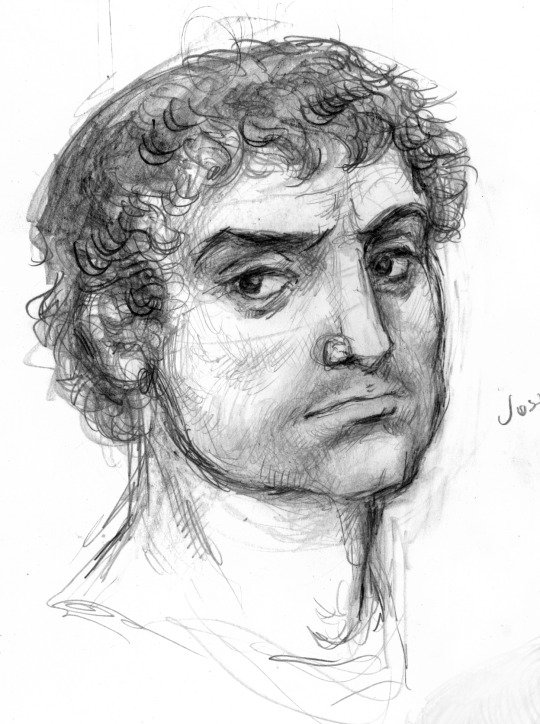
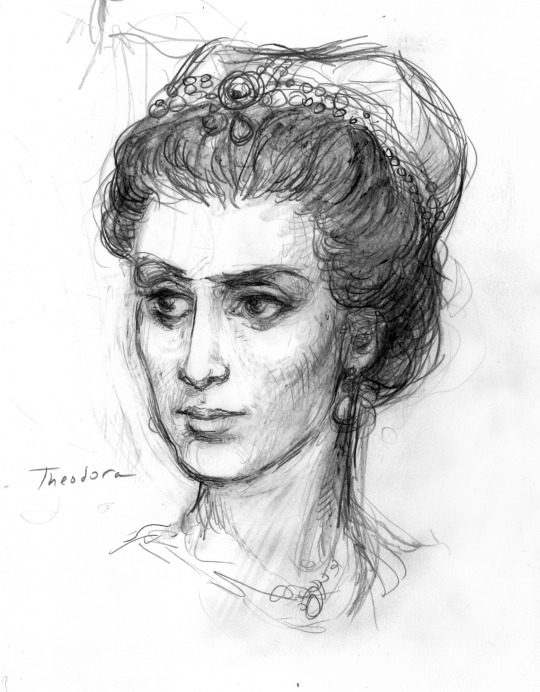
Good-bye 2023, hello 2024! One of my New Year's Resolutions is to draw more (whispers-- and to catch up on my commissions) and here are sketches of Byzantine emperor Justinian and his wife Theodora, based on the famous San Vitale mosaics and these busts of Justinian (and the bust of Theodora in Milan here).
#justinian#theodora#empress theodora#illustration#art#sketchbook#sketch#byzantium#byzantine empire#byzantine#justinian and theodora
113 notes
·
View notes
Text
Need a modern retelling of Justinian's life. Set it in a NYC that everyone just calls "The City", almost as one word. Have Justinian be a guy from the jersey suburbs who's uncle is chief of police who eventually becomes mayor. Have Theodora be an improv comedian (derogatory). Have the Blues and the Greens be Yankees and Mets coded, but like, still, chariot racing teams, because why no. Have the opening scene be Justinian and Theodora at a game laughing with their friends as the crowd chants "Charge! Charge! Charge!" over an ad with a big swoosh labeled "Nika: just do it". Have Belisarius be a velociraptor and nobody questions it (he's trying to conquer DC for completely unexplained reasons). Have it so halfway through as things seem to be going well COVID just full on happens exactly like it did in 2020. When the riots happen have them literally just be because the chariot fans are mad about cancel culture cancelling a couple of their players (he killed a guy in a DUI). Have the crackdown be insanity because the nypd just starts shooting for no reason
The story feels so modern it's just begging for a retelling
6 notes
·
View notes
Text
Porphyrios

Since 2020 there have been over 400 run-ins with orca whales off the coast of Spain. So far, they've sunk at least three ships and damaged dozens more. A ship's skipper, Daniel Kriz, who has had the orcas damage rudders on two different boats he's been on, says they're getting better at it too.
“In 2020, the attack lasted almost an hour and was not as organized,” Kriz said. “This time we could hear them communicating under the boat. It only took about 10 to 15 minutes.”
Why are whales suddenly going after boats with such determination and for such a long span of time? Scientists are unsure, leaning between the whales retaliating for harm a ship did them previously or simply becoming brave enough in their curiosity to unintentionally damage ships. Perhaps I am a bit too influenced by stories I've read but I would tend to believe the orcas know exactly what they're doing.
I also know this isn't the first time a whale has attacked, or sunk, a ship.
Perhaps the most modern famous one is the sperm whale that sunk the whaling vessel Essex in 1820, an incident that inspired Herman Melville to write Moby Dick in 1851.
But we can go further back than that.
Much further.
Let's go back to sixth century Constantinople. According to Procopius, a historian of the time from Caesarea, a great whale, 45 feet (13.7 meters) long and fifteen feet (4.6 meters) wide haunted the Strait of Bosporus and the waters around it. This whale wasn't just there to sight-see either. The whale attacked and sank ships it came across.
The sailors of the time named the monster Porphyrios.
There's debate what the name was derived from (other than the gut kick reaction to shout 'oh shit!' the second you saw the whale hove into view) but most scholars think the whale's name came from prophyra which meant a deep, purple color. This could have been referring to the color of the whale's skin or perhaps imbuing it with some of the terrifying, regal nature that nobles of the time, the only ones allowed to wear the purple, implied. Whales weren't well known in that area of the world at that time and we have no way of knowing what kind of whale it was. Speculation based on size leads many to believe it was a lost sperm whale a long way from home but it might have also been a large orca. Iberian orcas hunt the Straight of Gibraltar, following the bluefine tuna every year and they're the ones responsible for the recent ship attacks off the coast of Spain of the past few years. It's not hard to imagine one of them wandering east, deeper into the Mediterranean Sea, instead of heading back north when the tuna left. And Porphyrios didn't just set up shop anywhere. He decided that the Strait of Bosporus was his new hunting ground.
Here's the thing. The Strait of Bosporus was the main trade route for that part of the world. Goods flowed down to the Black Sea, crept through the narrow Strait of Bosporus which let out into the Sea of Marmara. One more strait, this one the Dardanelles, where the city of ancient Troy once controlled all trade out of the East, and then it was out into the Aegean Sea and then on to the Mediterranean. Trade goods could pass by on land but it added both dangers and time to the business and, most importantly, took all that sweet, sweet toll to use their water passage right out of Constantinople's hands. Having what amounted to a sea monster living in their main money-maker and convincing merchants to find other ways to bypass the strait, and therefor the city sitting on the edge of it, was disastrous for a country that was trying to restore itself to its former glory. Emperor Justinian I, also known as the Great, put out a bounty on the monster's head and did everything in his power to encourage its capture or eradication.
The tools of whaling used centuries later to drive many whale populations to the brink of extinction however were unknown at the time. Porphyrios shrugged off the arrows and spears lobbed at it and went on sinking ships, sending simple fishing vessels to the bottom of the ocean just as steadily as it did merchant and war ships. There was even a story that Justinian's famous general, Belisarius, loaded a catapult onto a ship to hunt the deadly whale, though this seems to be just a story and one which also failed to killed the great monster of the strait.
Porphyrios becoming a terror that merchant captains probably saw in their nightmares even when they were on dry land. Long routes far out of the way were taken to avoid waters he swam in. There would be lulls. For unknown reasons, Porphyrios would disappear for long periods of time, lulling ship captains and their crews into thoughts that the monster had died. It never lasted though and for over fifty years, Porphyrios hunted the ships of the Bosporus and its surrounding waters, damaging some and sending many more to the bottom of the ocean.
Nothing lasts forever though. One day, the story goes, Porphyrios was chasing dolphins in the Black Sea and ran aground. Struggling to get back to deeper water, it only churned up the dirt, sinking itself more completely into the mud. Locals that lived nearby saw what was happening and ran out to kill the great beast but their axes did little damage against its tough hide. In the end, they lashed ropes to to the whale and, using horses and wagons, dragged its great bulk to higher ground. There they finally managed to kill the beast, eventually hacking it to bits and eating the pieces. Porphyrios, killer of men and sinker of ships, terror of the Bosporus, was no more.
It was the first recorded case of a whale attacking ships.
It hasn't been the last.
Perhaps the Iberian orca, social animals that can teach each other how to disable and sink ships, tell stories, late at night when they rest in the waters off the coast of Spain, with the bright lights from the shore twinkling above the water like electric stars. Perhaps they tell stories of an ancestor who hunted strange waters -
and taught the humans in their noisy ships above what real fear was.

#porphyrios#whale#whales#orca#sea monster#history#constantinople#justinian#killer whales#orcas#turkey#bosporus strait
15 notes
·
View notes
Text

A 6th century mosaic image of Byzantine Emperor Justinian is in the Basilica di San Vitale in Ravenna, Italy. To his left is Bishop Maximianus of Ravenna with a label above his head.
5 notes
·
View notes
Text
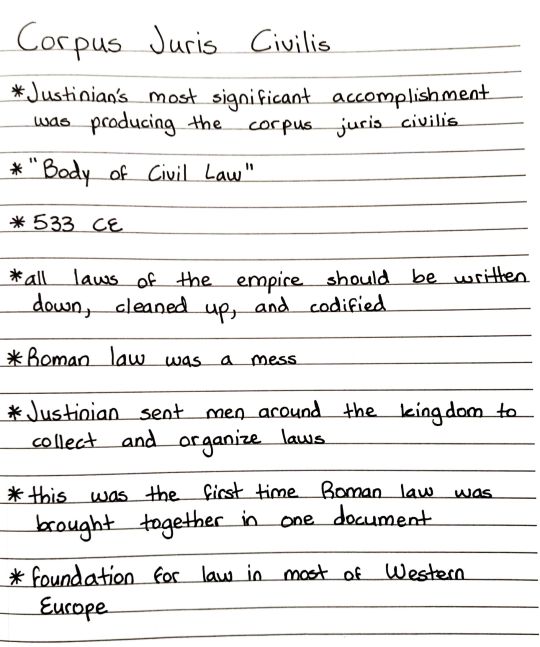
Patreon
#studyblr#notes#history#historyblr#history notes#world history#world history notes#western civ#western civilization#western civ I#western civ 1#justinian#emperor justinian#roman history#classical studies#roman emperors#roman law#ancient law#corpus juris civilis#european history#rome#ancient rome
11 notes
·
View notes
Text
Happy WIP WEDNESDAY everyone
This last week I have been really fixated on my fantasy world building project and have had lots of ideas for pieces I have wanted to make so start many many sketches some more developed than others, i have also started writing out the lore more i have so much knowledge of my world already especially since its a semi collaborative project with my partner, but I need to start writing it all put for people to read and know. I will be posting that at some point here, on my unvale and on my toyhouse





From top to bottom left to right
1 and 2- some sketches trying to design outfits for my oc’s Castor and Maya and how to represent their cultures within their clothing, they are both characters who are from one culture but then spend a lot of time in another culture and I want to figure out what that will look like for them as the cultures combine and clash.
3- Maya and the watcher -I have had this idea in the back of my mind for a long while and I have big plans for it I want it to be a fully rendered painted piece that represents on of her higher powered spells really excited to work on it more when I am a little less busy
4 and 5 - A portrait of Maya and her Beloved Imperas Beiti (keylas) inspired by the murals of Theodora and Justinian, i really wanted to make a full body pieces inspired by those but decided for now to just make specific icons for them as a portrait representation of them for my unvale/toyhouse etc maybe in the future I will do the full mural for both of them with my other ocs that fit as the advisors in the background (such as Stratkos Beiti taking Belisarius’ place)
#original character#digital art#artist#oc art#original art#digital artist#fantasy art#fantasy oc#clip studio paint#my art#fantasy girl#fox girl#wip#work in progress#my wip art#current wips#wip art#wip wednesday#digital sketches#oc sketches#fantasy sketches#large world building project#Andulas#Maya#Keylas#justinian#theodora#somniari
5 notes
·
View notes